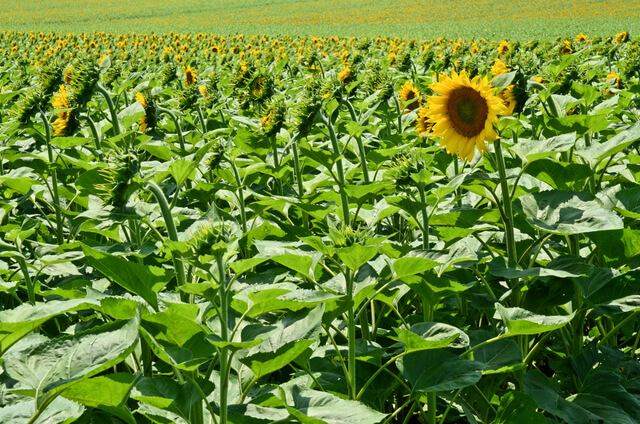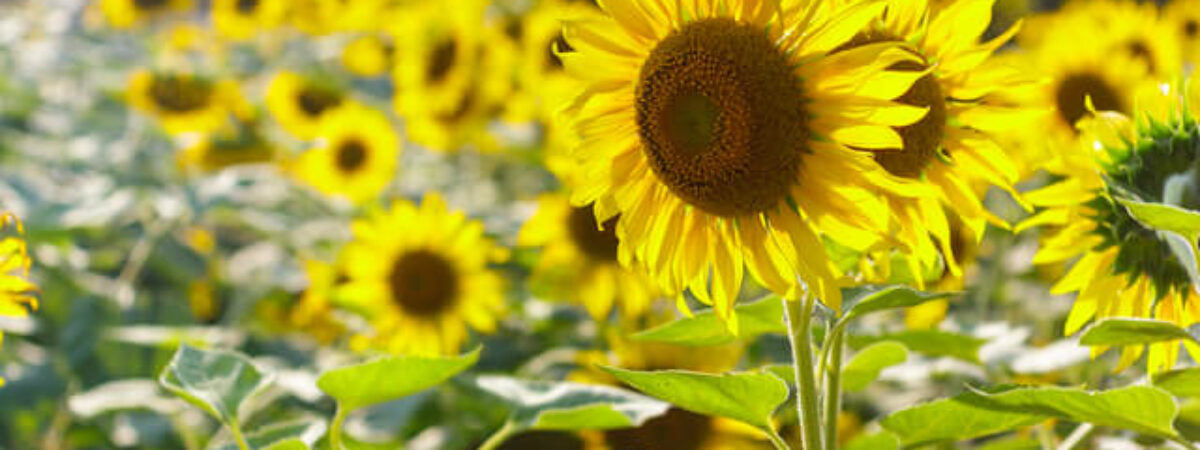With bright blooms that go all summer, the sunflower plant is such a plant that is resistant to pets, heat tolerant, and attractive to birds and pollinators, the sunflower plant is the best choice for most the gardeners as it is very easy to grow.
Scientifically known as the Helianthus annuus, this plant is an annual plant with a daisy-like flower face. Although it comes in many colors like yellow, red, orange, brown, and maroon, the yellow flower with a brown center filled with the seeds is best known among the people.
Sunflowers are generally heliotropic which means they move their face in the direction of the sun which means it moves from east to west with the movement of the sun in the sky, at night they finally come back east to their original place. Ready again for the next day’s morning sun.
Sunflowers are native to North America. Thus they can grow well in all regions. The plant is cultivated for its beautiful flowers for decorative and commercial purposes. Besides, the seeds are also used for harvesting and eating purposes.
There are a lot of varieties of sunflowers that are generally founded. So you have to choose the best of them that can fit in your ground.
Sunflowers are generally heliotropic which means they move their face in the direction of the sun which means it moves from east to west with the movement of the sun in the sky, at night they finally come back east to their… Click To TweetPlant overview
There are a lot of varieties of plants available today. Some of them have branching stems, some have single stems. Some plants are pollen-free and some can produce ample pollens for pollinators.
The largest variety of sun grows up to the height of 16 feet whereas the smaller groups can hardly grow up to the height of 1 foot and are heavily used to grow in containers and small spaces.
The flowers can grow rapidly. Most of the flowers mature in just 80 to 95 days. Coming to the size of the flower, if you plant it with a large-seeded variety, it can reach over 12 inches.

Varieties of sunflower plants
Below are some popular varieties of sunflowers
Mammoth
Mammoth is a popular variety of sunflowers with traditional giant sunflowers that can grow up to more than 12 feet tall. The seed of this plant can be used as snacks and bird feeders.
Autumn beauty
Autumn beauty is one of the most spectacular cultivars of sunflowers that bears flowers of the size of inches 6 inches in the shades of yellow, bronze, and mahogany. The branching stems grow up to 7 feet tall.
Teddy bear
With fluffy, deep gold, 5-inch blossoms that last for days, this plant is a perfect choice for containers and small gardens. The plant grows up to the height of 4 to 5 feet.
Sunrich gold
The pollen less, big, no-mess flower with rich golden yellow rays, and green-yellow centers, this variety of sunflower is about 5 feet tall and produces flowers of 4-5 inches. This variety is a great choice for bouquets and arrangements.

Perfect time to plant sunflowers
The seeds of the sunflower can be planted after the danger of spring frost has passed anytime and after the soil has warmed to at least 10°C. So you can plant a sunflower between mid-July in all regions. However, you should plant it between march to mid-April in the southern regions.
How to plant the sunflower seeds
If you are planting the sunflower in the ground, plant it in q to 2 inches deep and space them around 6 inches apart. You can also plan multiple seeds in a container and thin them into the smallest contender when they grow up to 6 inches tall.
If you are planting this plant in a container, Sow the seeds of sunflowers into individual pots of peat-free, multi-purpose compost. Sow one seed of the sunflower per 7.5cm pot. Press the seed 1.5cm into the compost and water in. Cover the pots with the help of a clear plastic bag and place them in a cool but bright place.
When the sunflowers have germinated, keep them well-watered until they’re ready to plant out at the end of May. Prepare the soil for the plantation of this plant by removing weeds and adding a lot of organic matter. Water the plant well and stake plants with a bamboo cane or similar.
The seeds of the sunflower can be planted after the danger of spring frost has passed anytime and after the soil has warmed to at least 10°C. So you can plant a sunflower between mid-July in all regions. Click To TweetProvide the plant especially the low-growing plants with lots of space so that they can grow broadly.
Add some light fertilizer to the plant. You need to apply fertilizer to the plant by mixing it at planting time to encourage strong root growth.
Spread netting over the planted area until the germination of seeds to protect the plant from the seeds
Caring guide of sunflower
Water
The sunflowers are generally drought tolerant. But watering it regularly helps to set the flowers. But ensure the topsoil is dry out from 1 to 2 inches.
This plant may require regular watering before the periods, during, and after the flowering of the plants.
Fertilizer
Sunflowers don’t need any fertilizer in most cases. However, they may require a slow-release granular fertilizer in case of poor soil. Make sure you don’t add too much nitrogen to the soil as it can inhibit the flowering.
Soil
Sunflowers are not picky about soils and thrive in every soil. They can even be grown in poor and dry soil. However, it grows well in the sandy loam soil and black soil. The soil of the plantation should be fertile and well-drained with contain a lot of organic matter.
When the soil pH is considered, these plants grow well in slightly alkaline soil which is around 6.5 to 8.0. Sowing this plant in acidic soil can harm the plant.
Light
The sunflower plant grows well in full sun meaning at least six hours of direct sun. keeping in full sun ensures the better flowering and sturdiest stems.
When the plant is exposed to the ample sun, it will help them to stand straight rather than bending towards the predominant light.
Temperature
The required temperature for the growth of the sunflower plant lies between 70 to 80 degrees Fahrenheit. But they are also tolerant to heavy heat as far as the moisture need of the plant is fulfilled. Besides, they also can handle the chilly and sunny environments.
Humidity
Sunflowers are the best plant grown ever. They can tolerant to high humidity. However, they may require well-draining soil and good air circulation to prevent root rot and other diseases.

Staking
Sunflowers that grow from seed and are sown directly in the garden will have well-established roots and stronger stems and be less likely to fall.
But those sunflowers that are huge and grow over 3 feet tall with large, heavy flower heads are more prone to flopping or even breaking due to the stress of summer winds and rain.
So to prevent this problem, loosely attach your plant’s branches to stakes with cloth or twine.
Propagation of the plant
Propagation of the sunflower plant can be done by the seeds. After flowering, the heads of the sunflower develop masses of sunflower seed. We harvest these plants to use in cooking but remember to remove the tough seed coat before eating.
So this can be done by taking the seed and leaving them to dry for a few days, before storing them in a paper envelope in a dry spot, so that you can sow them the next year.
Common pests and diseases
The sunflower is insect-free. However, sometimes small gray moth can lay their eggs on the plant that can be cured by picking up the worms from the flowers.
The seeds of the plant are very prone to be attacked by birds and insects. So if you want to plant the sunflower for its seeds then you need to cover the flower with white polyspun garden fleece.
If the sunflowers are showing the sign of dropping, that means the soil is dry and they may require more watering.
Sometimes rust, powdery mildew, and powdery mildew may attack the plant. It can be prevented by spraying a general garden fungicide.
Bottom lines
This sunflower plant is the best plant for every gardener, as it is a rapidly growing, beautiful addition to many gardens. It is also very easy to handle and attractive.
These usually don’t need any extra water, fertilizer, insect control, or trimming, and they can grow well in every type of soil and don’t require any maintenance. Despite this, they pay you with a beautiful look to your garden, seeds to use in snacks, oil, and bird feeders.
So consider this plant to grow in your backyard and enjoy your evening in a sunflower garden.
You may also like to read
How to grow and care for Tulip plants-A step by step guide
How to Grow and Care for Ground Orchids- A Step by Step Guide






